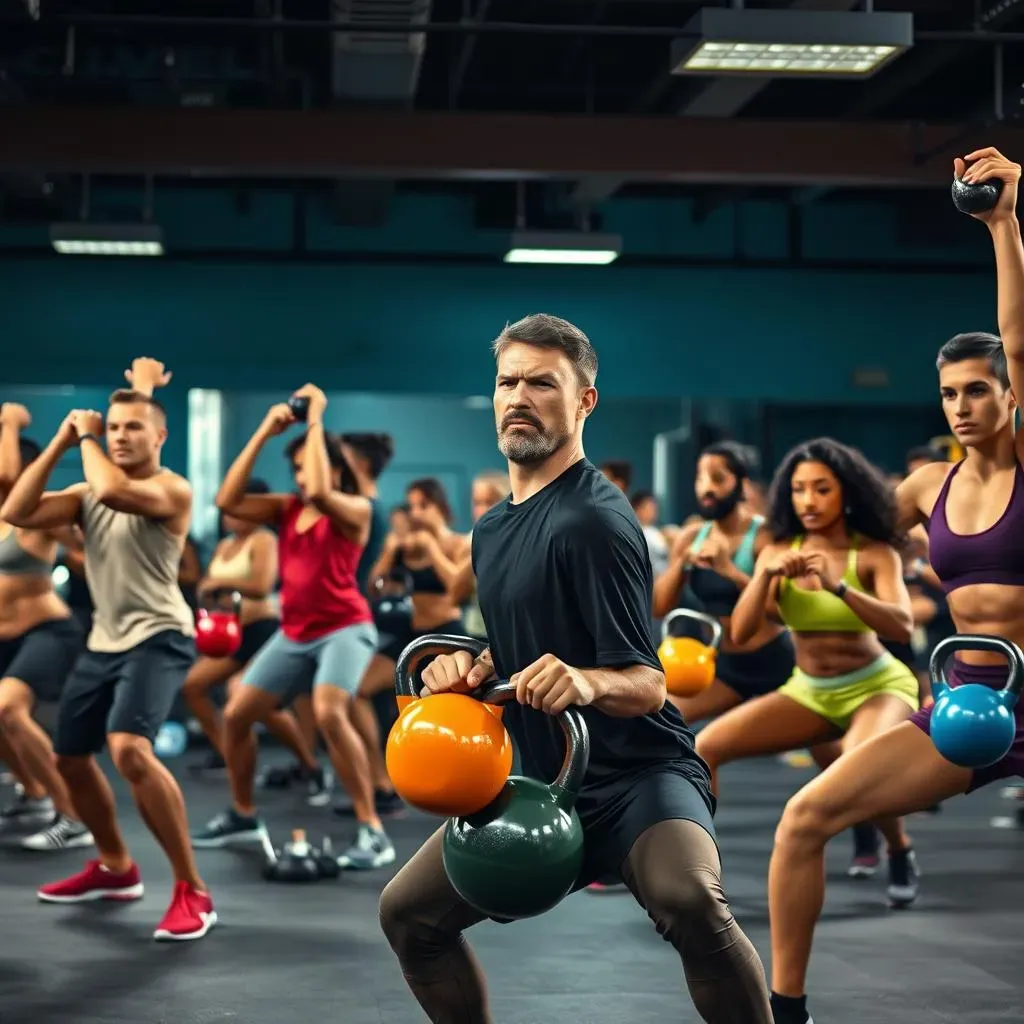Table of Contents
Ready to revolutionize your fitness routine? If you're looking to build strength, torch calories, and improve your overall athleticism, then it's time to embrace the power of the gym workout kettlebell. This isn't your average dumbbell routine; kettlebells offer a unique blend of cardio and strength training that will challenge your body in new and exciting ways. Kettlebells have been around for centuries, originating as Russian farm tools and evolving into a favorite among strongmen. Now, they're a staple in gyms worldwide, and for good reason. In this guide, we'll dive deep into the world of kettlebell training. We'll explore the incredible benefits these versatile tools offer, from building functional strength to enhancing your cardiovascular fitness. You'll learn how to select the perfect kettlebell weight for your fitness level and discover how often you should be incorporating kettlebell workouts into your weekly schedule. We'll break down 15 essential kettlebell exercises, providing step-by-step instructions and expert tips to ensure proper form and prevent injuries. Finally, we'll show you how to create a personalized kettlebell program that aligns with your fitness goals, helping you maximize your results and achieve the body you've always wanted. So, grab your kettlebell and let's get started!
Benefits of Integrating Kettlebell Exercises into Your Gym Workout

Benefits of Integrating Kettlebell Exercises into Your Gym Workout
Unlocking Full-Body Strength and Power
Forget isolating muscles; kettlebells are all about compound movements that engage your entire body. Think squats, swings, and snatches – these exercises force your core, legs, and upper body to work together, building functional strength that translates to real-world activities. Unlike traditional weightlifting, kettlebell training emphasizes explosive power, helping you develop the ability to generate force quickly. This is crucial for athletes and anyone looking to improve their overall athleticism.
Boosting Cardiovascular Fitness and Burning Calories
Looking for a way to combine strength training and cardio? Kettlebells have you covered. The dynamic nature of kettlebell exercises elevates your heart rate and keeps it there, providing a fantastic cardiovascular workout. This not only improves your endurance but also helps you torch calories and shed unwanted fat. A 2010 study by the American Council on Exercise (ACE) found that the average person can burn around 20 calories per minute during a kettlebell workout, making it a highly efficient way to lose weight.
Enhancing Core Stability and Improving Posture
A strong core is the foundation of any good fitness program, and kettlebells are excellent for developing core stability. Many kettlebell exercises require you to maintain a stable spine while moving the weight, which strengthens your core muscles and improves your balance. This, in turn, can lead to better posture and reduced risk of back pain. Furthermore, the offset loading of many kettlebell movements forces your core to work even harder to stabilize your body, leading to greater gains in core strength and stability.
Benefit | Description |
|---|---|
Full-Body Strength | Engages multiple muscle groups simultaneously. |
Cardiovascular Fitness | Elevates heart rate for calorie burning and endurance. |
Core Stability | Strengthens core muscles and improves balance. |
Improved Posture | Reduces risk of back pain. |
Choosing the Right Kettlebell Weight and Workout Frequency for Your Gym Routine

Choosing the Right Kettlebell Weight and Workout Frequency for Your Gym Routine
Finding Your Starting Weight
Alright, so you're ready to swing some iron! But before you go all out, let's talk about picking the right kettlebell weight. Starting too heavy is a recipe for disaster – hello, injuries! – while going too light won't challenge you enough to see results. As a general guideline, women often start with an 8kg (18lb) or 12kg (26lb) kettlebell, while men typically begin with 12kg (26lb) or 16kg (35lb). But remember, these are just starting points. Consider your current fitness level and experience with weight training. If you're a complete newbie, err on the lighter side. You can always increase the weight as you get stronger.
Also, the exercise matters! You might be able to swing a heavier kettlebell than you can press overhead. It's okay to use different weights for different exercises. Focus on maintaining proper form above all else. If you can't perform the exercise with good form, the weight is too heavy. A good test is to try a few reps of a basic exercise like the kettlebell swing. If you feel strain or discomfort, drop down to a lighter weight.
Structuring Your Weekly Kettlebell Workouts
Now that you've got your weight sorted, let's talk frequency. How often should you be hitting the gym with your kettlebell? The answer depends on your goals and fitness level. As a general rule, aim for 2-3 kettlebell workouts per week, with rest days in between. This allows your muscles to recover and rebuild. If you're new to kettlebells, start with two workouts per week and gradually increase the frequency as you get stronger.
Don't do kettlebell workouts every single day. Overtraining can lead to fatigue, injury, and burnout. Your muscles need time to repair themselves after a challenging workout. Listen to your body. If you're feeling sore or fatigued, take a rest day. You can also alternate kettlebell workouts with other forms of exercise, such as cardio or yoga. This will help prevent overuse injuries and keep your workouts fresh and exciting.
Sample Weekly Kettlebell Schedule
To give you a better idea, here's a sample weekly kettlebell schedule:
- Monday: Kettlebell Full-Body Workout
- Tuesday: Rest or Light Cardio
- Wednesday: Strength Training (different muscle groups)
- Thursday: Rest
- Friday: Kettlebell Full-Body Workout
- Saturday: Rest or Active Recovery (yoga, stretching)
- Sunday: Rest
Remember, this is just a sample schedule. Feel free to adjust it to fit your own needs and preferences. The most important thing is to be consistent and listen to your body.
15 Essential Gym Workout Kettlebell Exercises for FullBody Strength

15 Essential Gym Workout Kettlebell Exercises for FullBody Strength
Kettlebell Swings: The King of Kettlebell Exercises
If there's one exercise that defines kettlebell training, it's the swing. This dynamic movement works your entire posterior chain – glutes, hamstrings, and back – while also engaging your core and shoulders. It's a fantastic way to build power, improve cardiovascular fitness, and burn calories. To perform a kettlebell swing, stand with your feet shoulder-width apart, with the kettlebell a few inches in front of you. Hinge at your hips, keeping your back straight, and grab the kettlebell with both hands. Hike the kettlebell back between your legs, then explosively thrust your hips forward, swinging the kettlebell up to chest height. Control the kettlebell as it swings back down, repeating the movement for the desired number of repetitions. Remember, the power comes from your hips, not your arms!
Start with a lighter weight to master the form, focusing on the hip hinge movement and keeping your back straight. As you get more comfortable, you can gradually increase the weight and focus on generating more power with each swing. Kettlebell swings can be modified to suit different fitness levels. For beginners, a Russian swing (swinging the kettlebell to chest height) is a good starting point. More advanced lifters can try American swings (swinging the kettlebell overhead) for an added challenge.
Goblet Squats: Mastering the Squat with a Kettlebell Twist
The goblet squat is a fantastic variation of the traditional squat that can help you improve your form and build lower body strength. Holding the kettlebell in front of your chest encourages you to maintain an upright torso and engage your core, making it a great exercise for beginners and experienced lifters alike. To perform a goblet squat, hold the kettlebell close to your chest with both hands, as if you're cradling a goblet. Stand with your feet slightly wider than shoulder-width apart, with your toes pointed slightly outward. Lower your body down into a squat, keeping your back straight and your chest up. Aim to get your elbows between your knees at the bottom of the squat. Push through your heels to return to the starting position, squeezing your glutes at the top.
Goblet squats are a great way to learn proper squat form. The kettlebell acts as a counterbalance, helping you maintain balance and stability throughout the movement. If you have trouble squatting deep, try elevating your heels slightly by placing them on a small plate or weight. This will help you maintain a more upright torso and squat deeper. As you get stronger, you can increase the weight of the kettlebell or try variations like tempo squats or pause squats to further challenge your muscles.
Kettlebell Deadlifts: Building a Strong Foundation
The kettlebell deadlift is a fundamental exercise for building overall strength and power. It primarily targets your posterior chain – glutes, hamstrings, and back – while also engaging your core and grip. It's a great way to improve your lifting mechanics and build a strong foundation for more advanced kettlebell exercises. To perform a kettlebell deadlift, stand with your feet hip-width apart, with the kettlebell in front of you. Hinge at your hips, keeping your back straight, and grab the kettlebell with both hands. Keeping your core engaged and your back straight, lift the kettlebell off the ground by extending your hips and knees. Stand tall at the top of the movement, squeezing your glutes. Lower the kettlebell back to the ground by reversing the movement, maintaining a straight back throughout.
Start with a lighter weight to master the form, focusing on maintaining a straight back and engaging your core. As you get more comfortable, you can gradually increase the weight and focus on lifting with your legs and glutes, rather than your back. Kettlebell deadlifts can be modified to suit different fitness levels. For beginners, a Romanian deadlift (RDL) is a good starting point. This variation involves keeping your legs mostly straight and focusing on the hip hinge movement. More advanced lifters can try single-leg deadlifts for an added challenge to their balance and stability.
Exercise | Target Muscles | Benefits |
|---|---|---|
Kettlebell Swings | Glutes, Hamstrings, Core | Power, Cardio, Calorie Burning |
Goblet Squats | Quads, Glutes, Core | Lower Body Strength, Improved Squat Form |
Kettlebell Deadlifts | Glutes, Hamstrings, Back | Overall Strength, Lifting Mechanics |
Expert Tips for Perfecting Your Gym Workout Kettlebell Technique and Preventing Injury

Expert Tips for Perfecting Your Gym Workout Kettlebell Technique and Preventing Injury
Master the Fundamentals
Before you start throwing around heavy kettlebells, it's crucial to nail the fundamental movements. This means understanding the hip hinge, maintaining a neutral spine, and engaging your core. Think of the hip hinge as the foundation of most kettlebell exercises – it's the movement pattern you use in swings, deadlifts, and cleans. Practice this movement with a light kettlebell or even just your bodyweight until it becomes second nature. A neutral spine is also essential for preventing back injuries. Imagine a straight line running from your head to your tailbone, and try to maintain that line throughout the exercise. Finally, engage your core by bracing your abdominal muscles as if you're about to be punched in the stomach. This will help stabilize your spine and protect your lower back.
Consider filming yourself performing the exercises and comparing your form to videos of experienced kettlebell lifters. This can help you identify areas where you need to improve. It's also a good idea to work with a certified kettlebell instructor, especially when you're just starting out. They can provide personalized feedback and help you correct any technical flaws. Remember, proper form is more important than lifting heavy weight. Focus on mastering the fundamentals, and the weight will come naturally.
Prioritize Mobility and Warm-Up
Kettlebell training is dynamic and demanding, so it's essential to prioritize mobility and warm-up properly before each workout. Tight muscles and stiff joints can increase your risk of injury, so take the time to loosen up your body before you start swinging. Focus on exercises that improve hip mobility, shoulder mobility, and spinal flexibility. Some good examples include hip circles, arm circles, cat-cow stretches, and thoracic rotations. A dynamic warm-up is also crucial for preparing your muscles for the workout ahead. This involves performing a series of movements that gradually increase your heart rate and blood flow to your muscles.
Include exercises like bodyweight squats, lunges, push-ups, and light kettlebell swings. Aim for at least 10-15 minutes of mobility work and dynamic warm-up before each kettlebell workout. This will not only help prevent injuries but also improve your performance. You'll be able to move more freely, generate more power, and get more out of each exercise. Don't skip the warm-up! It's an investment in your long-term health and fitness.
Tip | Description |
|---|---|
Master Fundamentals | Hip hinge, neutral spine, core engagement. |
Prioritize Mobility | Improve hip, shoulder, and spinal flexibility. |
Warm-Up | Dynamic movements to increase heart rate and blood flow. |
Maximizing Results: Crafting Your Personalized Gym Workout Kettlebell Program

Maximizing Results: Crafting Your Personalized Gym Workout Kettlebell Program
So, you've mastered the fundamentals, you're swinging like a pro, and you're feeling the burn. Now it's time to take your kettlebell training to the next level by crafting a personalized program that aligns with your specific goals. Whether you're aiming to build strength, lose weight, improve endurance, or simply become a more well-rounded athlete, a well-designed program can help you achieve your desired results. The first step is to define your goals clearly. Are you looking to increase your strength and power? Focus on heavier weights and lower repetitions, with an emphasis on compound exercises like swings, cleans, and snatches. Are you trying to shed those extra pounds? Incorporate more high-intensity interval training (HIIT) with kettlebells, alternating between bursts of intense exercise and short periods of rest.
Elevate Your Fitness: The Kettlebell Advantage
Incorporating kettlebells into your gym workout is a game-changer. From explosive power to enhanced endurance and full-body strength, the benefits are undeniable. By understanding proper technique, choosing the right weight, and listening to your body, you can safely and effectively integrate kettlebells into your routine, transforming your fitness journey. Whether you're a seasoned athlete or just starting out, the kettlebell offers a dynamic and rewarding path to a stronger, healthier you. So, keep swinging, keep pressing, and keep pushing your limits – the kettlebell is your key to unlocking a new level of fitness.